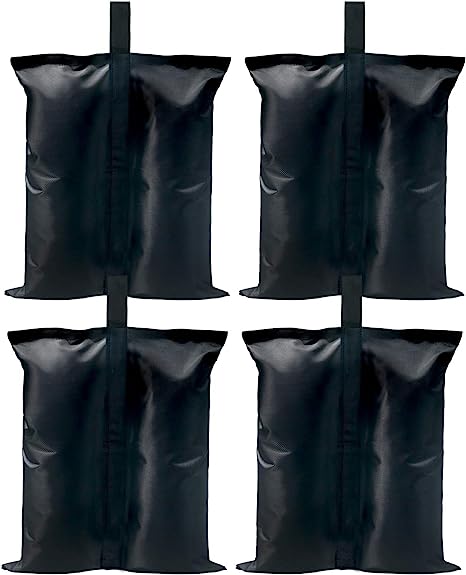A gazebo looks great in the backyard or any outdoor space, but outdoor high winds can easily cause discomfort. In some extreme situations, high winds can also make your gazebo unsteady.
It is why it’s essential to secure your gazebo from the wind to guarantee the security of everyone using it and to safeguard your investment.
Our thorough tutorial will provide you with all the knowledge you need to secure your gazebo from the wind, regardless of whether you are an experienced DIY enthusiast or a novice to outdoor home repair.
So, keep reading.
Things You Need To Secure a Gazebo From Winds
The supplies you’ll need to protect your gazebo from the wind are:
Kit for strengthening the poles: This kit should contain extra poles or brackets that can be utilized to strengthen the gazebo’s current framework. It will lessen the likelihood that the poles will bend or break in strong winds. Search on Amazon.
Cross braces: Cross braces are great for connecting the poles and adding additional stability to the gazebo. These can be bought or DIYed using supplies like metal pipes or wooden beams.
Screws and bolts: To attach the cross braces and reinforcing kit to the gazebo’s existing framework, you will need screws and bolts.
Sandbags, weights, stakes, or any other item that can be used to secure the gazebo to the ground are examples of anchoring materials.
Windbreaks: These can be used to lessen the wind’s impact on the gazebo. They can be made of panels, screens, or other materials.
Drill: A drill is required to attach the strengthening kit, cross braces, and windbreaks to the gazebo.
Measurement tape: A measuring tape is required to determine the required materials’ dimensions precisely.
It will be simpler to finish the process quickly and successfully if all these supplies are available before beginning.
Explore
Best Gazebo For High Winds in 2024
Discover the High-Quality, Durable, and Wind-Resistant Gazebos: Your Comprehensive Guide.
Assessing the Gazebo
Assessing the gazebo and its surroundings is the first step towards wind-securing it. After reading this, you’ll have a better idea of what has to be done to secure the gazebo and what supplies you might require.
The following are the essential components to look at:
- Verify the gazebo’s poles, roof, and other parts to ensure they are all in good shape. Keep an eye out for any damage or wear indicators like cracks, dents, or missing pieces. It will enable you to decide whether any repairs are required before moving on to the next stage.
- Look for places in the gazebo that might be more vulnerable to wind damage. It can apply to spaces where the structure is not firmly anchored to the ground, such as cracks in the roof or spaces between the poles.
- Examine the area close to the gazebo and consider how the weather and wind patterns might affect the building.


All this will help you plan the steps you need to take to finish the task and give you a better idea of what resources you require.
Strengthening the Structure
The next step in protecting a gazebo from the wind is strengthening the current framework.
In addition to giving the gazebo more stability, this will prevent the poles from bending or breaking in strong winds. The essential actions to do are as follows:
- The gazebo’s poles can be given further stability by using reinforcing kits. You may buy these kits expressly for your gazebo or make them yourself using metal pipes or wooden beams.
- You can join the gazebo’s poles with cross braces to add additional stability and keep the poles from bending in strong winds. You should uniformly space cross braces throughout the gazebo and firmly fasten them to the poles using screws or bolts.
- You can also strengthen the gazebo’s roof by adding more supports or bolstering the ones already there. It will lessen the likelihood of the roof collapsing in strong winds.


Anchoring the Gazebo
Anchoring the gazebo is a major part of protecting it from the wind. It will stop high winds from lifting or toppling the gazebo and give you peace of mind.
The essential actions to do are as follows:
Selecting the Best Anchors: The type of soil in your region and the weight of your gazebo will influence the type of anchors you use. Stakes, weights, or spikes are available options.


This kit provides ample weight to keep your gazebo securely anchored even in the high winds. The sandbags are also easy to fill and empty. We highly recommend this anchoring kit for almost every type of gazebo.
View On
Setting the Anchors in Place: The anchors should be positioned along the sides and at the gazebo’s corners if necessary. They ought to be placed so that they are firmly grounded—making it difficult for the wind to blow them away.
Setting up the Anchors: To install the anchors, drill a hole in the earth, place the anchor inside, and backfill the hole with sand or soil. For the best stability, the anchor should be placed so that it is perpendicular to the ground.
Adding Anchors and Securing the Gazebo: You should firmly secure the gazebo to the anchors once they are set up using ropes or straps. It would be best if you tightened the ropes or straps to ensure that the gazebo is secure and stable.
You can add another layer of defense against wind damage by securing the gazebo to the ground. The gazebo will stay sturdy even in the hardest gusts if it is well-fixed.
Remember to inspect the ropes and anchors to ensure they are still strong and secure. To maintain the stability and safety of your gazebo, you should repair any parts that show symptoms of wear or damage right away.
Installing Windbreaks
Windbreaks are an additional method of protecting a gazebo from the wind. To do this and lessen the amount of wind entering the area, walls or curtains can be installed around the gazebo.
The essential actions to do are as follows:
- Choosing the Right Windbreaks: Walls, drapes, or screens are just a few alternatives for windbreaks. The size of your gazebo, the local wind patterns, and personal preferences will influence your choice. Check this white windbreak panel or the colored one on Amazon.
- Evaluation of the Gazebo: Measure the space surrounding the gazebo before buying the windbreaks to ensure you have the right size. To ensure that the windbreaks offer sufficient wind protection, you also need to consider their height.
- Setting up the Windbreaks: The windbreaks can be put in place by clamping or hooking them or fastening them to the gazebo with screws or bolts. They ought to be placed to form a tight seal around the gazebo’s perimeter and are quite close to the ground.
- Keeping the Windbreaks Secure: You should firmly fix them in place to keep the windbreaks from shifting or flapping during strong gusts. You can accomplish this by attaching them to the gazebo’s poles or placing more weight on the windbreaks’ bottoms.


Subscribe For More Gazebo Videos!
Ask Gazebo
Maintaining the Gazebo
Regular maintenance of the gazebo is as important as installing windbreaks. Your gazebo’s lifespan can be increased with regular maintenance, which will also guarantee that it is in good working condition.
Some essential actions to do are as follows:
- Keep your gazebo clean and in good shape.
- Conduct routine inspections to look for any symptoms of damage or deterioration.
- Inspect the gazebo’s poles, roof, and other components for any indications of rust, corrosion, or other deterioration.
- Repair any worn or damaged components as soon as you spot any signs of damage.
- Assess the weather and make sure it is secure before using the gazebo.
How to keep the gazebo from blowing away?
Ok, let’s wrap it up. To protect your gazebo from the effects of the wind, you need to make sure the gazebo is well anchored; there aren’t any structural breaks already, install a strong windbreak, and regularly assess and maintain the gazebo in good condition.
You can utilize the weight anchors to protect its beams from shifting up. Take the gazebo down in high winds for better peace of mind.
FAQs
What kinds of materials are suitable for creating windbreaks for my gazebo?
You can use walls, drapes, or screens as windbreaks for your gazebo. The size of your gazebo, the local wind patterns, and personal preferences will influence your choice.
Consider checking How To Enclose A Gazebo With Plexiglass and How To Enclose A Gazebo With Screen.
How should windbreaks surround my gazebo?
The windbreaks can be put in place by clamping or hooking them or fastening them to the gazebo with screws or bolts. They ought to be placed to form a tight seal around the gazebo’s perimeter and are quite close to the ground.
How can I firmly anchor the windbreaks?
Attach the windbreaks with the gazebo’s pole with screws or bolts. Alternatively, you can place weight on the windbreak’s bottoms.
What should I do if my gazebo shows indications of wear or damage?
High winds can damage shingles, shift beams, cause structural instability, tear screens, and send pests inside the gazebo.
First, inspect for potential damage and determine the root cause. Then, pick up the right solution according to the problem. For example, if the wind has damaged your gazebo’s roof, you need to attach it back with solid screws.
What should I consider before utilizing my gazebo in a windy environment?
Consider the strength of the winds in your area; you can also check the forecast for that. The next thing to consider is the gazebo design and build quality. A high-quality permanent gazebo is more likely to be stable in high winds too.
Also, ensure that the gazebo is anchored properly and there are some windbreaks.
Conclusion:
Finally, protecting your gazebo from the wind will ensure its durability and safety.
Following the instructions in this article, you can take the essential precautions to guarantee that your gazebo stays stable and secure even during strong winds.
So, now that you know how to secure your gazebo from the winds, apply these recommendations.








Does growing trees in my backyard help to reduce the effect of high winds?
Yes, if you have big trees in your backyard, it will minimize the effect of winds and protect your outdoor structures. Trees work as windbreaks and protect the gazebo very well.